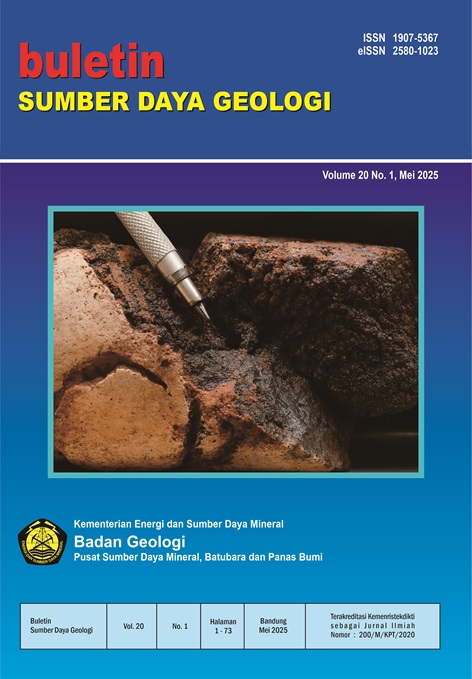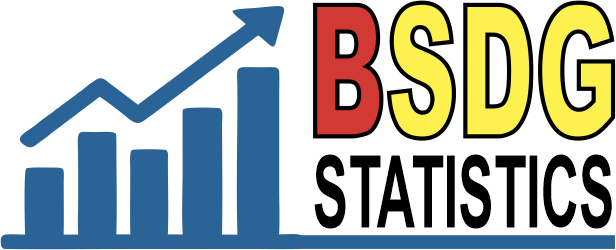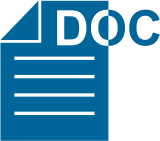KARAKTERISTIK FISIK, GEOKIMIA DAN SEBARAN ENDAPAN NIKEL LATERIT DAERAH LOJI BEACH, PULAU OBI, KABUPATEN HALMAHERA SELATAN, PROVINSI MALUKU UTARA
PHYSICAL, GEOCHEMICAL CHARACTERISTICS AND DISTRIBUTION OF NICKEL LATERITE DEPOSITS IN THE LOJI BEACH AREA, OBI ISLAND, SOUTH HALMAHERA DISTRICT, NORTH MALUKU PROVINCE
Abstract
Indonesia is one of the largest nickel producing countries in the world. One of the nickel producing areas in Indonesia is in the Loji Beach area. This research area is located on Obi Island, South Halmahera Regency, North Maluku Province. Geologically, the research area is composed of ultramafic rocks. This research aims to determine the characteristics of nickel laterite and its relationship with geological conditions in the research area using petrographic methods of rock samples and XRF (X-Ray Fluorescence) geochemistry of drilling samples. Geochemical data in the form of Ni content from drill data was interpolated using the IDW method using ArcGIS software. Based on research results, Ni-laterite is abundant in the morphology of gentle hills with a slope of 0-7%. The base rock bearing Ni-laterite is thought to be serpentinite from the serpentinization of harzburgite and dunite. Based on petrographic analysis, the bedrock is composed of >85% serpentine, the rest is relict minerals olivine and orthopyroxene, as well as other minerals such as talc, oxide minerals and opaque. The results of geochemical analysis show that in the limonite zone there is an abundance of Fe elements, while in the saprolite zone the Ni element is enriched with levels of 1.5% -2.8%.
Downloads
References
Ardiansyah, R., Kamaruddin, H., Rosana, F, M., & Yuningsih, T, E. (2019). Geokimia Endapan Nikel Laterit di Tambang Utara, Kecamatan Pomalaa, Kabupaten Kolaka, Provinsi Sulawesi Tenggara. Jurnal Geologi dan Sumber daya Mineral Vol.20. No.2 Mei 2019 hal 85 – 92.
Arifin, M., Widodo, S., & Anshariah. (2015). Karakteristik Endapan Nikel Laterit pada Blok X PT Bintang Delapan Mineral Kecamatan Bahodopi Kabupaten Morowali Provinsi Sulawesi Tengah. Jurnal Geomine, 1, 35 – 45.
Burger, P.A. (1996). Origins and Characteristic of Lateric Nickel Deposits. Nickel’96 Seminar Proceedings, Kalgoorlie.
Butt, Charles R. M., & Dominique Cluzel. (2013). “Nickel Laterite Ore Deposits: Weathered Serpentinites.” Elements 9(2):123–128.
E. J. W. Whittaker & J. Zussman. (1956). The Characterization of Serpentine Minerals by X-ray Diffraction Mineralogical Magazine 1956 31 : 107-126.
Elias, M. (2002). Nickel Laterite Deposits-Geological Overview. Resources and Exploitation, Centre for Ore Deposit Research, University of Tasmaniah. 205- 220.
Gill, Robin. (2010). Igneous Rock and Processes. Department of Earth Sciences Royal Holloway Univesity of London.
Golightly, J. P. (1981). Nickeliferous Laterite Deposits. Economic Geology 75th Anniversary, 710-735.
Haya, A., Conoras, W., & Firman. (2019). Penyebaran Endapan Nikel Laterit Pulau Obi Kabupaten Halmahera Selatan Provinsi Maluku Utara. Journal of Science and Engineering. Universitas Khairun. Ternate.
Pusat Sumber Daya Mineral, Batubara dan Panas Bumi. (2023). Neraca Sumber Daya dan Cadangan Mineral Batubara dan Panas Bumi Indonesia Tahun 2023. Bandung.
Khadafi, M., Danisworo, C., & Purwanto, S, H. (2013). Potensi Nikel Sulphida Daerah IUP Harita Di Pulau Obi Kabupaten Halmahera Selatan, Provinsi Maluku Utara. Jurnal Ilmiah MTG, Yogyakarta, Vol 6, No 2.
Kurniadi, A., Rosana, F, M., Yuningsih, T, E., & Pambudi, L. (2017). Karakteristik Batuan Asal Pembentukan Endapan Nikel Laterit Di Daerah Madang dan Serakaman Tengah. Padjadjaran Geoscience Journal, 1(2).
Le Bas, M. J., Streckeisen, A. L. (1991). The IUGS Systematics of Igneous Rocks. Journal of the Geological Society. London. Vol. 148, 1991, Hal. 825-833.
Letouzey J., de Clarens P., Guinard, J., & Berthon, J. L. (1983). Structure of the North Banda Mollucca Area From Multichannel Seismic Reflection Data. Procceding 12th Annual Convention of Indonesian Petroleum Association., Jakarta.
Lintjewas, L., Setiawan, I., & Kausar, A. Al. (2019). Profil Endapan Nikel Laterit di Daerah Palangga, Provinsi Sulawesi Tenggara. RISET Geologi Dan Pertambangan, 29(1), 91 – 104.
Moorhouse, W.W. (1959). The Study of Rocks In Thin Section. Harper and Brothers New York.
Mudd, G. M. (2009). Nickel sulfide versus laterite : the hard sustainability challenge remains. Proceeding 48th annual comference of metallurgist. Canadian metallurgist society. Sudbury : Ontario.
Sompotan, A.F. (2012). Struktur Geologi Sulawesi. Institut Teknologi Bandung, Bandung.
Sudana, D., A. Yasin., & K. Sutisna .(1994). Peta Geologi Regional Lembar Pulau Obi, Direktorat Geologi dan Sumber daya Mineral, Departemen Pertambangan Republik Indonesia, Bandung.
Utami, Z, N. (2022). Geologi dan Evolusi Tektonik Berdasarkan Geokimia Unsur pada Mineralisasi Nikel Sulfida PT. Sebuku Iron Lateritic Ores, Provinsi Kalimantan Selatan. Repository Universitas Jambi.
Van Zuidam, R.A., (1985). “Aerial and Geomorphology Mapping”. Smith Publisher The Hague, ITC.
Vaughan., D. J. & Chorkhill., C. L. (2017). Mineralogy of Sulfide. Sulfide Mineralogy and Geochemistry. Elements. Volume 13 : p 81-87.
Waheed, A. (2002). Nickel Laterites- A Short Course: Chemistry, Mineralogy, and Formation, of Nickel Laterites. Sorowako: PT International Nickel Indonesia.
Waheed, A. (2008). Nickel Laterites Fundamentals of Chemistry, Mineralogy, Weathering Processes, Formation, and Exploration. Sorowako: VALE Inco.
Winter, O.D. (2001). An Introduction To Igneous And Metamorphic Petrology. Prentice-Hall Inc. Upper Saddle River, New Jersey 07458.
Copyright (c) 2025 Buletin Sumber Daya Geologi

This work is licensed under a Creative Commons Attribution-NonCommercial-ShareAlike 4.0 International License.
Authors whose manuscripts are published agree to the following terms:
The publication rights of all journal manuscript materials published on the Buletin Sumber Daya Geologi website are held by the editorial board with the knowledge of the author (moral rights remain with the manuscript’s author).
The formal legal provisions for access to digital articles in this electronic journal are subject to the terms of the Creative Commons Attribution-ShareAlike (CC BY-SA) license. This means that Buletin Sumber Daya Geologi has the right to store, convert media/formats, manage in the form of a database, maintain, and publish the article without requesting permission from the author, as long as the author’s name is cited as the copyright holder.
Manuscripts published in both print and electronic formats are open access for educational, research, investigative, and library purposes. Beyond these purposes, the editorial board is not responsible for any violations of copyright law.















